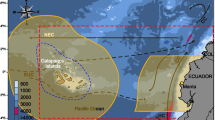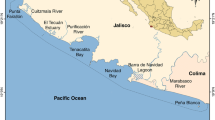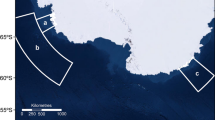Abstract
Sharks are top predators and play an important role in the regulation of marine ecosystems at lower trophic position. Mustelus californicus, Sphyrna zygaena, and Isurus oxyrinchus prove to be important fishery resources along the western coast of Baja California Sur and cohabit the same coastal areas, probably sharing resources. However, our knowledge about ecological dynamics of multiple species coexisting and sharing similar habitat resources is still limited, particularly for predators such as sharks. Therefore, this study focuses on the analysis of trophic ecology of the sharks species, using carbon (13C) and nitrogen (15N) stable isotope values in muscle tissues coupled with trace element concentration (Hg, Se, and Cd) in muscle and hepatic tissues of sharks. The values of δ13C (M. californicus −17.3 ± 1.1‰, S. zygaena −17.9 ± 0.5‰, and I. oxyrinchus −18.3 ± 0.3‰) and δ15N (M. californicus 18.2 ± 1.1‰, S. zygaena 18.4 ± 0.9‰, and I. oxyrinchus 17.8 ± 1.1‰) indicated that these species feed in the Gulf of Ulloa all throughout the year, and for extended periods with similar habitat use and trophic niche. The above-mentioned statement is also a conclusion supported by the significant correlation between isotopic and trace element concentrations in the muscular tissues in all studied species. Thus, the results of the present study emphasize the habitat and niche characteristics of three sympatric sharks off the coast of Baja California Sur, Mexico.





Similar content being viewed by others
Data availability
Isotopic and trace element data generated and analyzed are already shown and presented in this manuscript. Graphical material is proportioned in the journal submission platform.
References
Abascal FJ, Quintans M, Ramos-Cartelle A, Mejuto J (2011) Movements and environmental preferences of the shortfin mako, Isurus oxyrinchus, in the southeastern Pacific Ocean. Mar Biol 158:1175–1184. https://doi.org/10.1007/s00227-011-1639-1
Adams HD, McMichael RH Jr (1999) Mercury levels in four species of sharks from the Atlantic coast of Florida. Fish Bull 97:372–379
Albo-Puigserver M, Navarro J, Coll M, Aguzzi J, Cardona L, Sáez-Liante R (2015) Feeding ecology and trophic position of three sympatric demersal chondrichthyans in the northwestern Mediterranean. Mar Ecol Prog Ser 524:255–268. https://doi.org/10.3354/meps11188
Bearhop S, Adams CE, Waldron S, Fuller RA, MacLeod H (2004) Determining trophic niche width: a novel approach using stable isotope analysis. J Anim Ecol 73(5):1007–1012. https://doi.org/10.1111/j.0021-8790.2004.00861.x
Becerra Rueda OF (2014) Evaluación de la ecotoxicidad por los elementos potencialmente tóxicos generados por la minería de El Triunfo BCS. Doctoral dissertation, Instituto Politécnico Nacional Centro Interdisciplinario de Ciencias Marinas
Cadena-Cárdenas L (2004) Mercurio total en peces elasmobranquios y teleósteos del Golfo de California. M.Sc dissertation, Instituto Tecnológico del Mar, Guaymas, Sonora 75 pp.
Cartamil D, Santana-Morales O, Escobedo-Olvera M, Kacev D, Castillo- Geniz L, Graham JB, Rubin RD, Sosa-Nishizaki O (2011) The artisanal elasmobranch fishery of the Pacific coast of Baja California, Mexico. Fish Res 108:393–403. https://doi.org/10.1016/j.fishres.2011.01.020
Castro JI (1993) The shark nursery of Bulls Bay, South Carolina, with a review of the shark nurseries of the southeastern coast of the United States. Environ Biol Fishes 38(1–3):37–48. https://doi.org/10.1007/BF00842902
Compagno LJV (1984) FAO Species Catalogue. Vol. 4. Sharks of the world. An annotated and illustrated catalogue of shark species known to date. Part 2 - Carcharhiniformes. FAO Fish Synop 125(4/2):251–655
Cyr A, Sergeant CJ, Lopez JA, O’Hara T (2016) Assessing the influence of migration barriers and feeding ecology on total mercury concentrations in Dolly Varden (Salvelinus malma) from a glaciated and non-glaciated stream. Sci Total Environ 580:710–718. https://doi.org/10.1016/j.scitotenv.2016.12.017
D’Anglejan BF (1967) Origin of marine phosphorites off Baja California, Mexico. Mar Geol 5(1):15–44. https://doi.org/10.1016/0025-3227(67)90066-7
De Pinho AP, Guimarães JRD, Martins AS, Costa PAS, Olavo G, Valentin J (2002) Total mercury in muscle tissue of five shark species from Brazilian offshore waters: effects of feeding habit, sex, and length. Environ Res 89(3):250–258. https://doi.org/10.1006/enrs.2002.4365
Dudley SF, Simpfendorfer CA (2006) Population status of 14 shark species caught in the protective gillnets off KwaZulu–Natal beaches, South Africa, 1978–2003. Mar Freshwater Res 57(2):225–240. https://doi.org/10.1071/MF05156
Dulvy NK, Baum JK, Clarke S, Compagno LJ, Cortés E, Domingo A, Valenti S (2008) You can swim but you can’t hide: the global status and conservation of oceanic pelagic sharks and rays. Aquat Conserv 18(5):459–482. https://doi.org/10.1002/aqc.975
EPA (2000) Guidance for assessing chemical contaminant data for use in fish advisories (3rd ed), Fish sampling and analysis, vol. 1, U.S. Environmental Protection Agency, Washington, DC (2000) EPA-823-B-00-007
Espinoza M, Farrugia T, Lowe C (2011) Habitat use, movements and site fidelity of the gray smooth-hound shark (Mustelus californicus Gill 1863) in a newly restored southern California estuary. J Exp Mar Biol Ecol 401:63–74. https://doi.org/10.1016/j.jembe.2011.03.001
Espinoza M, Munroe SE, Clarke TM, Fisk AT, Wehrtmann IS (2015) Feeding ecology of common demersal elasmobranch species in the Pacific coast of Costa Rica inferred from stable isotope and stomach content analyses. J Exp Mar Biol Ecol 470:12–25. https://doi.org/10.1016/j.jembe.2015.04.021
Ferretti F, Worm B, Britten GL, Heithaus MR, Lotze HK (2010) Patterns and ecosystem consequences of shark declines in the ocean. Ecol. Lett 13:1055–1071. https://doi.org/10.1111/j.1461-0248.2010.01489.x
Francis M, Shivji M, Duffy C, Rogers P, Byrne ME, Wetherbee B, Tindale SC, Lyon W, Meyers M (2018) Oceanic nomad or coastal resident? Behavioural switching in the shortfin mako shark (Isurus oxyrinchus). Mar Biol 166:1–16. https://doi.org/10.1007/s00227-018-3453-5
Fry B (2006) Stable isotope ecology, vol 521. Springer, New York
Gaxiola CG, Durazo-Arvizu R, Lavaniegos-Espejo B, De la Cruz-Orozco ME, Millán-Núñez E, Soto-Mardones L, Cepeda-Morales J (2008) Respuesta del ecosistema pelágico a la variabilidad interanual del océano Pacífico frente a Baja California. Nota de Investigación. Cienc Mar 34 (2):263–270. https://doi.org/10.7773/cm.v34i2.1413
Goñi-Godoy G (2017) Trophic ecology of the brown smooth hound shark Mustelus henlei (Gill, 1863) using stable isotopes and stomach content analyses in BahÍa Tortugas, Baja California sur, México. Bachelor dissertation, Universidad de Las palmas de Gran Canaria, 36 pp
Heithaus MR, Frid A, Vaudo JJ, Worm B, Wirsing AJ (2010) Unravelling the ecological importance of elasmobranch. In: Carrier JC, Musick JA, Heithaus MR (ed), Sharks and their Relatives. II. Biodiversity, Adaptative Physiology and Conservation. CRC Press, Boca Raton, FL, pp 611–636
Heupel MR, Lédée EJ, Simpfendorfer CA (2018) Telemetry reveals spatial separation of co-occurring reef sharks. Mar Ecol Prog Ser 589:179–192. https://doi.org/10.3354/meps12423
Heupel M, Munroe S, Lédée EJ, Chin A, Simpfendorfer C (2019) Interspecific interactions, movement patterns and habitat use in a diverse coastal shark assemblage. Mar Biol 166:1–17. https://doi.org/10.1007/s00227-019-3511-7
Jackson AL, Inger R, Parnell AC, Bearhop S (2011) Comparing isotopic niche widths among and within communities: SIBER–Stable Isotope Bayesian Ellipses in R. J Anim Ecol 80(3):595–602. https://doi.org/10.1111/j.1365-2656.2011.01806.x
Joung S, Hsu H (2005) Reproduction and embryonic development of the shortfin mako, Isurus oxyrinchus Rafinesque, 1810, in the northwestern Pacific. Zool Stud 44(4):487–496
Kim SL, del Rio CM, Casper D, Koch PL (2012) Isotopic incorporation rates for shark tissues from a long-term captive feeding study. J Exp Biol 215(14):2495–2500. https://doi.org/10.1242/jeb.070656
Kim SL, Koch PL (2012) Methods to collect, preserve, and prepare elasmobranch tissues for stable isotope analysis. Environ Biol Fishes 95(1):53–63. https://doi.org/10.1007/s10641-011-9860-9
Layman CA, Araujo MS, Boucek RCM, Harrison E, Jud ZRP, Matich AE, Rosenblatt JJ, Vaudo LA, Yeager DM, Post SB (2012) Applying stable isotopes to examine food web structure: an overview of analytical tools. Biol Rev Camb Philos Soc 87:545–562. https://doi.org/10.1111/j.1469-185X.2011.00208.x
Loor AP, Galván-Magaña F, Elorriaga VFR, Polo SC, Delgado HA (2015) Population and individual foraging patterns of two hammerhead sharks using carbon and nitrogen stable isotopes. Rapid Commun Mass Spectrom 29:821–829. https://doi.org/10.1002/rcm.7169
Lowe CG, Bray RN (2006) Fish movement and activity patterns. In: Allen LG, Horn MH, Pondella DJ (eds) The ecology of California marine fishes. University of California Press, Berkeley
Lyons K, Kacev D, Preti A, Gillett D, Dewar H (2019) Organic contaminants as an ecological tool to explore niche partitioning: a case study using three pelagic shark species. Sci Rep 9(1):1–7. https://doi.org/10.1038/s41598-019-48521-6
Lysy M, Stasko AD, SwansonHK (2014) nicheROVER: (Niche) (R)egion and Niche (Over)lap Metrics for Multidimensional Ecological Niches (Version 1.0). Retrieved from https://cran.r-project.org/web/packages/ nicheROVER/index.html (accessed 2016-01-03)
Macías-Carballo M (2010) Variabilidad espacial de la forma espectral del fito- plancton y su relación taxonómica en abril 2008 en la zona occidental de Baja California. Bachelor dissertation, Universidad Autónoma de Baja California Sur, 132pp.
MacNeil MA, Skomal GB, Fisk AT (2005) Stable isotopes from multiple tissues reveal diet switching in sharks. Mar Ecol Prog Ser 302:199–206. https://doi.org/10.3354/meps302199
Malpica-Cruz L, Herzka SZ, Sosa-Nishizaki O, Lazo JP (2012) Tissue-specific isotope trophic discrimination factors and turnover rates in a marine elasmobranch: empirical and modeling results. Can J Fish Aquat Sci 69(3):551–564. https://doi.org/10.1139/f2011-172
Mann HB, Whitney DR (1947) On a test of whether one of two random variables is stochastically larger than the other. Ann Math Statist 18(1):50–60. https://doi.org/10.1214/aoms/1177730491
Massey Jr, Frank J (1951) The Kolmogorov–Smirnov test for goodness of fit. J Ame Statist Assoc 46 (253):68–78. https://doi.org/10.1080/01621459.1951.10500769
Maya CI, Torres RYE, Galván MF, Aguiñiga GS, Trasviña CLD (2016) Trophic overlap between blue shark (Prionace glauca) and shortfin mako (Isurus oxyrinchus): trophic linkages between two shark species in the Eastern Pacific Ocean food web. Food Webs 7:13–19. https://doi.org/10.1016/j.fooweb.2016.03.002
Maz-Courrau A, López-Vera C, Galván-Magaña F, Escobar-Sánchez O, Rosiles-Martínez R, Sanjuán-Muñoz A (2012) Bioaccumulation and biomagnification of total mercury in four exploited shark species in the Baja California peninsula, México. Bull Environ Contam Toxicol 88(2):129–134. https://doi.org/10.1007/s00128-011-0499-1
Medina-Trujillo EC (2013) Descripción de los movimientos del tiburón mako, Isurus oxyrinchus, en el Pacífico Nororiental usando telemetría satelital. M.Sc dissertation, CICESE, Ensenada, BC, 83 pp
Méndez-Da Silveira ED (2015) Composición isotópica de carbono y nitrógeno en tejidos de tiburones de la costa occidental de Baja California Sur. M.Sc dissertation, Centro Interdisciplinario de Ciencias Marinas-Instituto Politécnico nacional, 103 pp
Méndez-Da Silveira EM, Torres-Rojas Y, Galván-Magaña F, Sánchez-González A, Elorriaga-Verplancken F, Tripp-Valdéz A, Delgado-Huertas A (2020) Trophic interactions between shark species on the western coast of Baja California Sur: inferences from stable isotopes. Reg Stud Mar Sci 39:101463. https://doi.org/10.1016/j.rsma.2020.101463
Méndez-Macías JS, Velazquez-Chiquito VM, Estupiñan Montaño C, Galván- Magaña F (2019) Trophic ecology and ontogenetic shift in the diet of the sicklefin smoothhound (Mustelus lunulatus) in the southeastern Pacific Ocean. Fish Bull 117(3):245–258. https://doi.org/10.7755/FB.117.3.11
Miller DJ, Lea RN (1976) Guide to the coastal marine fishes of California (Vol. 157). State of California, Department of Fish and Game, San Diego, CA
Minagawa M, Wada E (1984) Stepwise enrichment of 15N along food chains: further evidence and the relation between δ15N and animal age. Geochim Cosmochim Acta 48(5):1135–1140. https://doi.org/10.1016/0016-7037(84)90204-7
Mollet HF, Cliff G Jr, Pratt HL, Stevens JD (2000) Reproductive biology of the female shortfin mako, Isurus oxyrinchus Rafinesque, 1810, with comments on the embryonic development of lamnoids. Fish Bull 98:299–318
Moreno-Sanchez XG, Escobar-Sánchez O, Abitia-Cardenas LA, Cruz-Escalona VH (2012) Diet composition of the sicklefin smooth-hound shark Mustelus lunulatus caught off El Pardito Island, Baja California Sur, Mexico. Mar Biodivers Rec 5. https://doi.org/10.1017/S1755267212000504
Morrissey JF, Gruber SH (1993) Home range of juvenile lemon sharks, Negaprion brevirostris. Copeia 425–434. https://doi.org/10.2307/1447141
Murchie KJ, Power M (2004) Growth-and feeding-related isotopic dilution and enrichment patterns in young-of-the-year yellow perch (Perca flavescens). Freshw Biol 49(1):41–54. https://doi.org/10.1046/j.1365-2426.2003.01163.x
Newsome SD, Martínez del Rio C, Bearhop S, Phillips DL (2007) A niche for isotopic ecology. Front Ecol Environ 5:429–436. https://doi.org/10.1890/060150.01
Newsome SD, Tinker MT, Monson DH, Oftedal OT, Ralls K, Staedler MM, Estes JA (2009) Using stable isotopes to investigate individual diet specialization in California sea otters (Enhydra lutris nereis). Ecology 90(4):961–974. https://doi.org/10.1890/07-1812.1
Ochoa -Díaz R (2009) Espectro trófico del tiburón martillo Sphyrna zygaena Linnaeus, 1758) en Baja California Sur: Aplicación de δ13C y δ15N. M.Sc dissertation, CICIMAR 66 pp
Papastamatiou YP, Wetherbee BM, Lowe CG, Crow GL (2006) Distribution and diet of four species of carcharhinid shark in the Hawaiian Islands: evidence for resource partitioning and competitive exclusion. Mar Ecol Prog Ser 320:239–251. https://doi.org/10.3354/meps320239
Pantoja-Echevarría LM, Marmolejo-Rodríguez AJ, Galván-Magaña F, Arreola-Mendoza L, Tripp-Valdéz A, Verplancken FE, Sujitha SB, Jonathan MP (2020) Bioaccumulation and trophic transfer of Cd in commercially sought brown smoothhound Mustelus henlei in the western coast of Baja California Sur, Mexico. Mar Pollut Bull 151:110879. https://doi.org/10.1016/j.marpolbul.2019.110879
Pantoja-Echevarría LM, Tamburin E, Marmolejo-Rodríguez AJ, Galván-Magaña F, Elorriaga-Verplancken F, Delgado-Huertas A, Tripp-Valdéz A, Arreola-Mendoza L, Lara A (2020) Stable isotopic inferences on trophic ecology and habitat use of brown smooth-hound Mustelus henlei in the west coast of Baja California Sur, Mexico. Reg Stud Mar Sci 40:101520. https://doi.org/10.1016/j.rsma.2020.101520
Platell ME, Potter IC, Clarke KR (1998) Resource partitioning by four species of elasmobranchs (Batoidea: Urolophidae) in coastal waters of temperate Australia. Mar Biol 131:719–734. https://doi.org/10.1007/s002270050363
Platell ME, Potter IC (2001) Partitioning of food resources amongst 18 abundant benthic carnivorous fish species in marine waters on the lower west coast of Australia. J Exp Mar Biol Ecol 261(1):31–54. https://doi.org/10.1016/S0022-0981(01)00257-X
Polo-Silva CJ, Galván-Magaña F, Delgado-Huertas A (2012) Trophic inferences of blue shark (Prionace glauca) in the Mexican Pacific from stable isotope analysis in teeth. Rapid Commun Mass Spectrom 26(14):1631–1638. https://doi.org/10.1002/rcm.6275
Portman JE (1976) Guidelines for the use of biological accumulations in marine pollution monitoring. Manual of Methods in Aquatic Environment Research. FAO Fisheries Technical Paper (150), p 89
Post DM (2002) Using stable isotopes to estimate trophic position: models, methods, and assumptions. Ecology 83(3):703–718. https://doi.org/10.1890/0012-9658(2002)083[0703:USITET]2.0.CO;2
R Development Core Team (2008) R: a Language and Environment for Statistical Computing. R Foundation for Statistical Computing, Vienna
Ramírez-Amaro SR, Cartamil D, Galván-Magaña F, González-Barba G, Graham JB, Carrera-Fernández M, Escobar-Sánchez O, Sosa-Nishizaki O, Rochín-Alamillo A (2013) The artisanal elasmobranch fishery of the Pacific coast of Baja California Sur, México, management implications. Sci Mar 77(3):473–487. https://doi.org/10.3989/scimar.03817.05A
Sánchez A, López-Ortíz BE, Aguíñiga García S, Balart S (2013) Distribution and composition of organic matter in sediments of the oxygen minimum zone of the Northeastern Mexican Pacific: paleoceanographic implications. J Iber Geol 39(1):111–120. https://doi.org/10.5209/rev_JIGE.2013.v39.n1.41753
Sánchez-Cota JA (2016) Hábitos alimentarios de tres especies del género Mustelus, Mustelus californicus, Mustelus henlei y Mustelus lunulatus, en Bahía Tortugas, Baja California Sur, México. Bachelor dissertation, Universidad Autónoma de Baja California Sur
Shiffman DS, Gallagher AJ, Boyle MD, Hammerschlag-Peyer CM, Hammerschlag N (2012) Stable isotope analysis as a tool for elasmobranch conservation research: a primer for non-specialists. Mar Freshwater Res 63:635–643. https://doi.org/10.1071/MF11235
Shipley ON, Murchie K, Frisk M, O’Shea O, Winchester MM, Brooks E, Pearson J, Power M (2018) Trophic niche dynamics of three nearshore benthic predators in The Bahamas. Hydrobiologia 813:177–188. https://doi.org/10.1007/s10750-018-3523-1
Stevens JD, Bonfil R, Dulvy NK, Walker PA (2000) The effects of fishing on sharks, rays, and chimaeras (chondrichthyans), and the implications for marine ecosystem. ICES J Mar Sci 57:476–494. https://doi.org/10.1006/jmsc.2000.0724
Tamburin E, Kim S, Elorriaga-Verplancken F, Madigan D, Hoyos-Padilla M, Sánchez-González A, Hernández-Herrera A, Castillo-Géniz JL, Godinez-Padilla CJ, Galván-Magaña F (2019) Isotopic niche and resource sharing among young sharks (Carcharodon carcharias and Isurus oxyrinchus) in Baja California, Mexico. Mar Ecol Prog Ser 613:107–124. https://doi.org/10.3354/meps12884
Tamburin E, Elorriaga-Verplancken F, Estupiñán-Montaño C, Madigan D, Sánchez-González A, Padilla MH, Wcisel MA, Galván-Magaña F (2020) New insights into the trophic ecology of young white sharks (Carcharodon carcharias) in waters off the Baja California Peninsula, Mexico. Mar Biol 167:1–14. https://doi.org/10.1007/s00227-020-3660-8
Tilley A, López-Angarita J, Turner JR (2013) Diet reconstruction and resource partitioning of a Caribbean marine mesopredator using Stable Isotope Bayesian Modelling. PLoS One 8(11):e79560. https://doi.org/10.1371/journal.pone.0079560
Tinker MT, Bentall G, Estes JA (2008) Food limitation leads to behavioral diversification and dietary specialization in sea otters. Proc Natl Acad Sci USA 105:560–565. https://doi.org/10.1073/pnas.0709263105
Tobin AJ, Mapleston A, Harry AV, Espinoza M (2014) Big fish in shallow water; use of an intertidal surf-zone habitat by large- bodied teleosts and elasmobranchs in tropical northern Australia. Environ Biol Fishes 97:821–838. https://doi.org/10.1007/s10641-013-0182-y
Van Geen A, Husby DM (1996) Cadmium in the California current system: tracer of past and present upwelling. J Geophys Res Oceans 101:3489–3507. https://doi.org/10.1029/95JC03302
Vaudo J, Heithaus M (2011) Dietary niche overlap in a nearshore elasmobranch mesopredator community. Mar Ecol Prog Ser 425:247–260. https://doi.org/10.3354/meps08988
Wedepohl KH (1995) The composition of the continental crust. Geochim Cosmochim Acta 59(7):1217–1232. https://doi.org/10.1016/0016-7037(95)00038-2
White WT, Platell ME, Potter IC (2004) Comparisons between the diets of four abundant species of elasmobranchs in a subtropical embayment: implications for resource partitioning. Mar Biol 144:439–448. https://doi.org/10.1007/s00227-003-1218-1
Yang DY, Chen YW, Gunn JM, Belzile N (2008) Selenium and mercury in organisms: interactions and mechanisms. Environ. Rev. 16:71–92. https://doi.org/10.1139/A08-001
Acknowledgements
We thank the Mexican fishery communities of Las Barrancas area for collaborating with us to support the sampling process.
Funding
The Instituto Politecnico Nacional (COFFA, EDI), CONACYT project 25370, Instituto Politecnico Nacional grants 20181417 and 20196736 and SIP20211002 and SIP2152 provided the fellowships to support this study.
Author information
Authors and Affiliations
Contributions
LMPE and ET conceived the manuscript and data curation, analyzed and interpreted the data, and writing and editing of the manuscript. FREV, AJMR, FGM, ATV, AL, MPJ, SBS, ADH, and LAM contribute to the manuscript and edited all the draft versions of the manuscript. FREV is the corresponding author responsible of the communication with the journal. All authors read and approved the final manuscript
Corresponding author
Ethics declarations
Ethics approval and consent to participate
All applicable international, national, and/or institutional guidelines for the care and use of animals were followed. All sampling process and experimental procedures in this study were performed complying with Mexican legislation.
Consent for publication
All authors authorized the publication in this journal and their participation in this manuscript. Anyway, this manuscript does not use any individual person’s data in any form.
Competing interests
The authors declare no competing interests.
Additional information
Responsible Editor: V.V.S.S. Sarma
Publisher's note
Springer Nature remains neutral with regard to jurisdictional claims in published maps and institutional affiliations.
Rights and permissions
About this article
Cite this article
Pantoja-Echevarría, L.M., Tamburin, E., Elorriaga-Verplancken, F.R. et al. How to stay together? Habitat use by three sympatric sharks in the western coast of Baja California Sur, Mexico. Environ Sci Pollut Res 29, 61685–61697 (2022). https://doi.org/10.1007/s11356-022-19530-2
Received:
Accepted:
Published:
Issue Date:
DOI: https://doi.org/10.1007/s11356-022-19530-2




